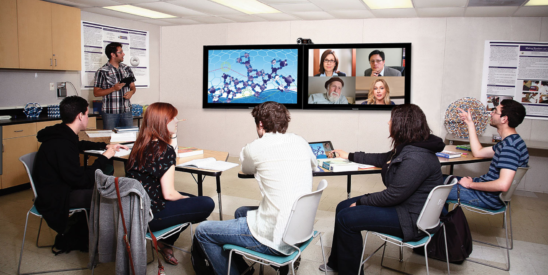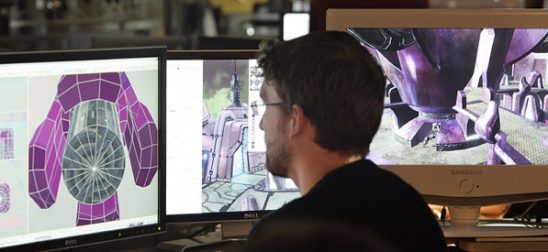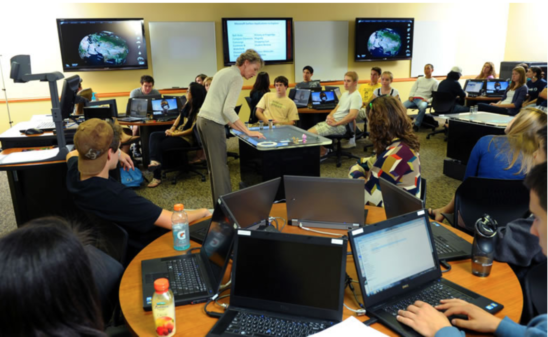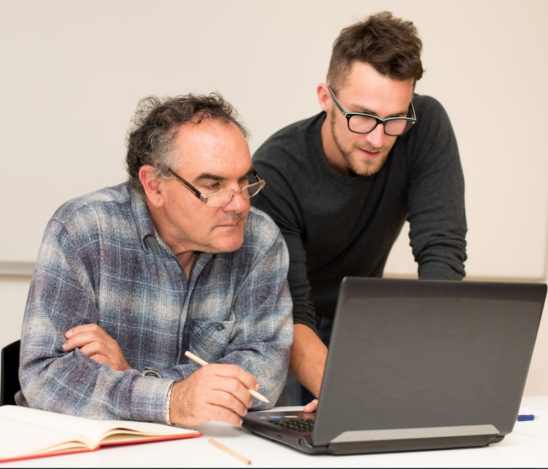
One of the responses I had to my series on the coming crisis to post-secondary education in Canada was: ‘Well, what do you think the higher education should look like in 10 years time if you think it’s in trouble now?’
‘Should’ is a dangerous word, and predicting the future is a mug’s game. I think though that it is a useful exercise to consider possibilities, and to think about whether we like them or not. I find scenario-building useful in thinking about possible future goals and in getting discussion going about future directions. If we don’t identify the future we want we can hardly complain if we don’t get it.
In this spirit, I offer this scenario from a national newspaper 10 years from now. Note I am focusing entirely on a public higher education system, a system supported by government with the aim of making it as open and as equitable as possible.
CASCADIA ON AN ECONOMIC ROLL
The Metropolitan News: September 30, 2030
Jennifer Wu
Universities and colleges: the engine of the economy
The government released today its annual report on the state of the economy for the financial year 2029-2030. Once again it showed that we lead all North American jurisdictions in annual growth of real GDP, averaging 2.9% in 2029-2030. This is the third successive year that our GDP has increased by more than 2.5%. It is a clear indication that Cascadia has come out relatively unscathed from the world economic recession in 2024. The digital services economy, particularly financial and technology services, is leading the growth, but some of the growth is also due to increasing productivity in manufacturing, mining and forestry, and food and agricultural products.

A number of experts give credit for this growth to the changes made in the post-secondary education sector between 2020 and 2025. I went to look at what’s different today, compared with 2019.
The move to blended learning
The first thing I noticed was how quiet the campuses were compared to when I was a student. Despite overall enrolments having increased by 15 per cent since 2019, the number of students attending campus has dropped considerably. This is due mainly to a rapid increase in blended learning.
I talked to Gina Stephanius, the Provost at the Metropolitan University. ‘Yes, our traditional face-to-face classes are down 60% from 2019’, she said. ‘This is because a lot of the studying that students do is either online or experiential, such as co-op programs and work placements. The second factor is the large increase in lifelong learners, who study mainly from home – or their workplace. Our programs now are designed to be ongoing and continuous, with ‘benchmark’ qualifications continuously being added as our learners continue to learn.’

As she walked me around the campus, I was struck by the amount of space given over to social and communication activities for students and faculty. There were open spaces with wall-mounted screens and comfortable seating areas where students could plug in their phones or tablets and project their work on to the screens. There were vending machines for coffee and snacks. Students were often huddled in groups of three or four, working on some assignment or project. Sometimes I came across a faculty member having a cup of coffee and an impromptu discussion with several students. The offices of individual instructors have deliberately been located close to these social areas.
I talked to a couple of the students. One said: ‘It’s more convenient to study at home or on my way to work. I only come in about once a week, but that’s very valuable, as I like to get to know the other students and see my prof occasionally.’ The other one said: ‘When I’m here though I want to do things that are more difficult or impossible to do at home, like use equipment or try things out on other students for feedback. I don’t see the point of lectures anymore – I can always look up the stuff.’
Stephanius commented that these were non-formal learning spaces for students, but even the formal classroom space has radically changed from the lecture halls and classrooms of ten years ago.
‘As early as 2018, we started to introduce interactive, team-based classrooms. Now these are the norm. They provide an opportunity for establishing and designing project work, for students to bring in their work, and for them to share their ideas and work with their fellow students. Basically, we make the students do the work. In most of our programs we get the students to find information, evaluate it, apply it to practical applications and even to some extent contribute to the assessment of each others’ work. This reflects how they will have to behave in the workplace, but our research shows it is also a very effective learning strategy.

‘And of course we still have labs, but they are very different from 10 years ago. AI and cloud computing are now essential tools in most STEM and many social science subjects, so our labs often contain high-end equipment and software that is not easily available, or can’t be used securely, from home. Many of our labs include virtual or augmented reality and games-based approaches to provide students with intermediary experience of using equipment, decision-making under pressure, patient treatment, and intuitive thinking for research purposes. We have to make their bus ride worthwhile as otherwise they can do most of their work from anywhere.’
The Provost ended with one last point. ‘You know, since we moved more extensively into blended and fully online learning, the university has considerably reduced its carbon footprint. Commuting from both staff and students is down by around 30 per cent from 2019, despite the 15% increase in our enrolments. That wasn’t our main intent, but it’s a very important side benefit of blended and online learning.’

Curriculum reform: changing the way students learn
Another important factor in the impact of post-secondary education on the economy was the slew of changes made to the design of programs during 2020-2025.
The City Institute of Advanced Technology was always a leader in online learning as a two year college, but it was also one of the first in Cascadia to bring in what was first called competency-based learning but which CIAT broadened into high-level skills development. I talked to Mohammed Aslim, the head of their environmental studies program.
‘The problem we faced’, he said, ‘was that AI was increasingly doing the easy stuff in teaching. Any processes that were routine or repetitive, there was an online AI program for it that students could take at much lower cost from a commercial provider such as Lynda.com or from Alphabet Education. They were eating our market. ‘
He went on: ‘Forget content delivery. Almost all the content we need to teach is already out there on the Internet, either as open educational resources or freely available through the Internet. There are several AI programs that can collate and ‘rate’ content for students, and test them on their comprehension – you’ll often find these AI programs packaged with commercial online textbooks.’
‘It’s much more difficult though,’ he continued, ‘for AI to use that information for decision-making or to assess the unintended consequences of inappropriate applications of such knowledge. AI still can’t handle value-based decision-making or intuitive thinking or ‘thinking outside the box’, even though it can offer up some suggestions if there is a large enough data set.’
Aslim continued: ‘This meant we had to focus on the hard stuff, and that is high-level skills development that requires a skilled person – an instructor, although I prefer the term ‘counsellor’ – to help with the learning and training. So we had to focus on those areas, and surprise, surprise, these high level skills are exactly what employers are looking for in our students.’
According to Aslim, another factor in pushing curriculum reform was the accountability system introduced by government that required institutions to demonstrate what skills students were developing and their impact on the labour market as a condition of direct government funding. This meant finding ways to successfully assess skills development, and demonstrate that learning to third parties such as employers or government.
One way this has been done at CIAT has been through the development of secure, authentic online portfolios that demonstrate students’ abilities in a range of high-level skills, and the contexts in which they have applied them. These are dynamic portfolios that capture the continuing development in skill levels as learners continue to learn throughout life. Blockchain is used to guarantee security and avoid tampering.
Aslim finally added: ‘The most important outcome though of our move to high-level skills development is that both we and our students have learned a great deal about the strengths and weaknesses of AI, and that has clearly carried over into the students’ eventual or current work environment. It also helped CIAT to grow from a two year vocational college into an Institute of Advanced Technology.’
Succeeding in the economy: the importance of lifelong learning
One of the more interesting statements in the government’s economic review was that while temporary unemployment remains high, with around 8 per cent of the workforce without a job for less than three months at any one time, overall unemployment when temporary unemployment is factored out is hovering around the very low figure of 3 per cent. This reflects not only a relatively high ‘churn’ in jobs, with 8 per cent ‘in-between’ jobs, but also that there are good jobs available for most workers, although it may take up to three months to find them. This compares very favourably with some other jurisdictions in North America, particularly in parts of the USA, where structural or long-term unemployment is still running at 20% after the 2024 global recession.
Lifelong learning is one reason ascribed to our success in managing to maintain high levels of employment in a highly volatile economy, and for the quick recovery from the recession. To find out more about this I went to talk to Maurice Dodenhof, the Dean of Continuing Education at the Downtown University.
‘The first thing you should know is that at DU we have more students over 25 years of age than under 25, even in terms of full time equivalents. In dollar terms, they are bringing in about 60 per cent of our tuition revenue. The actual number of individual students taking at least one continuing education course at DU is now approaching 100,000. This is really helped by the lifelong learning study vouchers provided by government to all lifelong learners. However, most of these lifelong learners are not taking courses from the School of Continuing Education, but from the main Faculties.
‘This is because we did a radical review of lifelong learning at DU in 2020. We realised that in a volatile digital economy, lifelong learning and retraining were essential for economic development and personal growth. Someone at 18 years old today is almost certainly going to have 15 to 20 different jobs or employers over their lifetime. Two thirds of our undergraduate students will eventually work in a job that doesn’t yet exist. We need to be there to support our learners throughout life.

‘Then when we look at the academic disciplines, they are also changing very fast. More and more we need generalists with specialist skills. Those specialist areas are developing new knowledge at an astonishing rate. So this means enabling our alumni to adapt to their changing needs for learning throughout their life.
‘Perhaps the biggest change we made was to scrap the bachelor’s degree at DU and replace it with what we call a laddered system with choice points along the ladder. We still have what you might call foundational programs, but there is no clear end point after that. This is particularly important when you consider skills development. Critical thinking does not stop when you have done four years at university. In fact as you get more experience you should get better at it. Our aim at DU is to provide that scaffolding or support for critical skills development throughout the lives of our alumni.
‘This means that every academic department needs to have a strategy for lifelong learning, for updating and renewing curriculum, and offering new, consistently relevant courses and programs.
‘The second big change was to bring in a slew of new qualifications in a much more modular, laddered fashion. So we now have two year foundational programs in the humanities, social sciences, science and engineering, which are effectively multi-disciplinary and skills focused. Then we have degree-level specialist courses that can build on foundation programs and lead to what we call a level 1 degree.
‘Since all these specialist courses are also skills-based, nearly all assessment at this level can be taken by challenge, whenever a student feels he or she can demonstrate competence in the course to the specified levels. We’ve had mature students come in and take the whole level 1 program successfully by challenge, but that’s rare – most need some form of teaching or course access to succeed. However, students, without registering for a full program, can also get a micro-qualification for a single specialist course or several related courses can be combined into a certificate or diploma, which can be stored and used as a credit towards completion of a level 1 degree.
‘After level 1, students can continue to take further courses on either a full-time or a part-time basis. Some of these courses can be very short – two weeks or even less, for which students get a micro-credential, but again, these micro-credentials can be built up towards a level 2 degree, which would be equivalent to the old professional masters’ level. Alternatively students can take full 13 weeks courses at a more advanced level than level 1 courses towards a level 2 degree.
‘We also have agreements in place with many universities around the country to accept their courses and programs, and they can be combined with ours towards a level 2 degree. Students can come back at any time to take these level 2 modules or courses, as well as graduates from other universities and colleges. Most of these courses are offered by the main faculties, with advice and professional support from Continuing Education staff.
‘We are able to offer these lifelong learning opportunities because of our Continuing Education Advisory Council. The main work is done through the Council’s employment sector sub-committees, which include faculty from relevant academic departments as well as representatives from industry and government.
‘Continuing Education itself is now called the Open University Downtown, offering level 1 and level 2 courses to anyone who wants to take them, whether qualified for university entrance or not. If students are successful in these open enrolment courses, they can use these as both a qualification towards entry to the main DU academic programs and/or towards a level 1 or 2 qualification. Many of these courses are MOOCs offered by other institutions which our academic departments have approved, but we have also developed quite a lot of MOOCs ourselves. These OU Downtown programs have been particularly useful to new immigrants who do not initially meet our university entrance requirements, although we also have a surprisingly large number of ‘local’ mature students who did not complete high school but now need qualifications in order to get work.
New business models
I then went to talk to Marylee Wang, the VP-Administration at DU, to ask how the university can afford so many lifelong learning students, and why they have been so successful in recruiting them.
‘When our strategic planning indicated a likely large drop in students coming through from high school for demographic reasons, and increasing demand for continuing education in the workforce throughout the life of our alumni because of the volatile economy, we needed a strategy to encourage the academic departments to take on more direct responsibility for lifelong learning.
‘What we did effectively was to change our business model. Previously, all the funding from government, tuition fees and other sources went into a large pot and then was reallocated, mainly on historical grounds – you get what you had last year, plus or minus a small percentage depending on the overall financial status of the university at the time. Lifelong learning was basically outsourced to Continuing Studies.
‘George Stanislaw, the Dean of Entrepreneurial Studies, argued that the university itself had to become more entrepreneurial. He suggested that while we should keep the original financial model for the regular bachelor degree programs (now our level 1 courses), academic departments should be allowed to keep most of the tuition fees from lifelong learning courses and programs, with deductions for direct services provided by the university (overheads). This made sense because most of the lifelong learners are mainly or entirely studying online, so their overhead costs are considerably lower than campus-based students. Our lifelong learning courses are no more expensive for students than the campus programs, but in most cases are fully self-financing from the tuition fees, and much of these are covered by the government’s lifelong learning vouchers.
‘The beauty of this model is that the new income allowed the academic departments to hire extra faculty to teach these courses, thus automatically allowing lifelong learning to expand according to demand. Because we knew students could afford to pay if we offered the right programs, the university started lending funds to academic departments to get them going in lifelong learning. This strategy has been immensely successful, as can be seen both by the numbers and by the financial sustainability of the strategy.’
The main challenges
Universities and colleges in most other jurisdictions have been much slower to change, and indeed we have seen many public higher education systems collapsing in the wake of the 2024 recession and the aggressive educational offerings of the international network platforms. I wanted to find out what enabled our universities and colleges to make these changes for survival. I went to talk to the President of the Universities’ Council, Michaela Swarthmore, to find out more.
‘Well,’ she laughed, ‘it wasn’t easy. I think most Presidents and Boards of Governors in the 2020s understood that the academy was under threat to external forces, particularly the large international network platforms, but also to an increasing number of governments wishing to privatise higher education. This became even more threatening in 2024 when frankly many governments just did not have the cash to fund higher education appropriately. What we needed was a revolution in teaching, in order to be more skills-focused and more student-focused to ensure the support of the general public, but the main – but not the only – challenge to change was helping our own faculty change their teaching methods.
‘The first challenge was the rewards system. We were rewarding faculty for their research, not their teaching. Success in research was in practice the main criterion for appointment, tenure and promotion. The second challenge was their lack of training in teaching methods. Their Ph.D.s were primarily qualifications in research. Up to 2020, faculty training in teaching was purely voluntary, and there was no agreed curriculum for training instructors in higher education, although the two-year colleges did have an out-dated certificate program for college instructors. The Presidents all agreed that this needed to change, but no-one wanted to go first, because they were afraid they would lose their best faculty and more importantly, the best graduate students, to other universities, if there was mandatory training for teaching.
‘It was at this point that the government stepped in (although I have to admit the Council did do a little private lobbying first). In 2021, the government mandated that in order to receive direct funding from the government, every post-secondary institution must have in place a validated program for training and development in skill-based teaching.
‘Eventually it was agreed that there would be four elements to the program:
- All post-graduates who wished to teach in post-secondary institutions must have a minimum, government recognised, three month diploma in post-secondary teaching methods, which was developed by the Universities’ Council.
- Secondly, all new hires without this diploma would need to take it within two years of their appointment.
- Third, all existing faculty would need to take the diploma within five years.
- Lastly, the Council commissioned an external agency to co-develop a professional accreditation framework for post-secondary teaching based on a portfolio of teaching that is peer assessed.

‘The Council obtained agreement from all its institutional members that promotion of faculty should take into account these qualifications in teaching, as well as research accomplishment.
‘The main challenge though came from the faculty associations, who initially argued that this was an attack on academic freedom. This was only finally resolved in 2025, when a large number of state universities were closed in the USA as a result of the recession and increased competition from the international network companies.
‘We as senior administrators also realised we needed better professional training, particularly in managing technology-based teaching, so we set up a somewhat similar system for Deans, AVPs Teaching and Learning, and other senior administrators that covered essentials such as strategic planning, learning technology support, and funding models.
‘As I said, it wasn’t easy, but without these changes I doubt if we could have been so successful.’
Facing the future
Although our public post-secondary system appears to be very successful, there is a constant threat from international network companies, who are still experimenting with different ways to provide professional training and development on a commercial basis.
As Mohammed Aslim put it: ‘They only have to get it right once, and we will be in great peril. We have to have a public post-secondary system that is more citizen-focused, more concerned with the development of the individual, as well as corporate needs. We have to show that we are better and different from the competition and can provide true value to our learners if we are to survive and succeed.’
Over to you!
So what do you think?
- Is this a desirable future for post-secondary education? If so, is it feasible?
- If not, what should we be aiming for? Could you offer an alternative scenario?
- Or am I being unduly alarmist? Is the current system basically sound and just needs a few tweaks and a bit more (or a lot more) public money?
I’d really like to hear from you. Please use the comment box below (just keep scrolling). Alternatively, if you wish to remain anonymous, send an email to tony.bates@ubc.ca, and I will add it anonymously, but I will need your name and institution (which I will keep confidential) to ensure it is a genuine contribution to the discussion. As many readers are away on vacation, I look forward to your comments when you return to work!









 Dr. Tony Bates is the author of eleven books in the field of online learning and distance education. He has provided consulting services specializing in training in the planning and management of online learning and distance education, working with over 40 organizations in 25 countries. Tony is a Research Associate with Contact North | Contact Nord, Ontario’s Distance Education & Training Network.
Dr. Tony Bates is the author of eleven books in the field of online learning and distance education. He has provided consulting services specializing in training in the planning and management of online learning and distance education, working with over 40 organizations in 25 countries. Tony is a Research Associate with Contact North | Contact Nord, Ontario’s Distance Education & Training Network.

